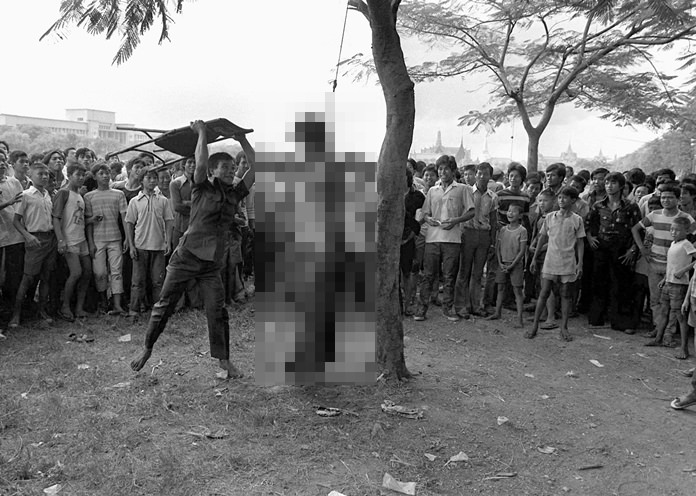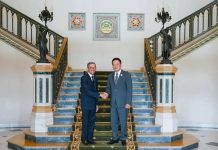Bangkok (AP) – A battered body hangs from a tree as a man swings a folding chair over his head, preparing to smash it into the corpse. Spectators watch intently at a slight distance, some smiling, as if watching a puppet show.

A photo of that moment immortalizes the bloody events of Oct. 6, 1976, when heavily armed security forces shot up Bangkok’s Thammasat University campus and killed scores of students, while right-wing vigilantes captured and lynched would-be escapees. Even so, what happened there, and why, is to some degree forgotten in Thailand.
“Younger Thai people look at the photo and ask where it is from,” said Australian filmmaker David Tucker, who is making a documentary about the killings. “They have no idea about the sixth of October. Some say, ‘It must have come from another country. It couldn’t have happened in Thailand.’ People old enough to remember October 6 can guess where it is from and some have seen the picture before, but generally speaking, people are reluctant to talk.”
How reluctant? No one in that Pulitzer Prize-winning photo – the victim, the attacker or any of the dozens of spectators – has been identified in the 40 years since Associated Press photographer Neal Ulevich shot it.
That fact intrigued Tucker, who has teamed up with Thai researchers who are attempting to put names to the long-ago faces. They hope to harness the power of social media to elicit more information, and this week their website, http://www.6Oct-photo.com went live.
“The event is hard to reconcile with how Thais see themselves,” Tucker said. “They are famous for being a gentle and harmonious society and yet right here in the middle of their history is an event that is characterized by savagery and violence, right in the middle of downtown Bangkok.”
Three years before the 1976 killings, students spearheaded protests forcing Thailand’s unpopular military dictators to flee the country, ushering in real parliamentary democracy. It was a tumultuous time to manage such a transition. In 1975, three neighboring countries – Vietnam, Laos and Cambodia – had been taken over by communists. Thailand had been a staunch ally of the United States in the Vietnam War, but Washington was now turning tail in Southeast Asia, and its protective shield carried no convincing guarantee.
To Thailand’s establishment, democracy looked messy, divisive, pitting farmers against landowners, workers against employers. The Marxist rhetoric of student activists hinted at an enemy within.
In the autumn of 1976, the students overplayed their hand when they protested the return to Thailand of one of the ousted dictators. A skit meant to represent the police killing of two activists was misrepresented by right-wing media. Students kept up their protests even as army-backed right-wing groups began to howl for blood.
By midnight Oct. 5, the 3,000 to 4,000 protesting students inside Thammasat were under siege. Irate royalists and organized thugs gathered outside gates that the students had locked for their own protection. Police, many from heavily armed special units trained for combat, fired revolvers, assault rifles, grenade launchers and even anti-tank weapons upon the students, a handful of whom are believed to have returned fire with small arms.
By midmorning, the police were sweeping the university grounds and buildings, making their student prisoners strip off shirts and lie face down on the central athletic field. Thugs rushed in unimpeded, trying to snatch vulnerable students on the fringes, even seeking to take the wounded from ambulances.
Hanged bodies were battered until unrecognizable. Corpses had stakes driven into them. A pyre was made of four casually stacked victims. All of it was in plain view on a public field outside the university.
Ulevich took the photo of the hanging, one of 12 photos of the scene that earned him a Pulitzer, just after leaving the university grounds. He had been anxious that if he stayed too long, his film might be seized.
“When I got to the campus gate,” he said in an interview at his Colorado home last week, “I saw a commotion under two trees in the large common field that is in the center of Bangkok.
“I walked over to one and saw the man with the chair beating one of the hanged bodies over the head. Two trees away there was another hanged body. They were both quite dead by that time.”
The official death toll was 46; more reliable estimates from scholars put it upwards of 100.
When the army seized power later that day, it imposed a news blackout. Newspapers were temporarily shut down, film and notes seized from reporters. A TV announcer who put footage of the carnage on air was immediately fired.
But pictures from international news and broadcast agencies beat the blackout. Newspapers around the world published the shocking images.
It was 20 years before Thais even began commemorating the massacre, with a mass gathering at Thammasat and the organized publication of many books. Smaller commemorations then became a tradition, but in 2014, the military government ordered politics to be kept out of the proceedings.
The junta has shown no signs of interfering with this year’s commemorations, though its critics are among the organizers and events have been expanded for the first time to two other Bangkok universities.
Ulevich’s photo is the main design element for many of the posters marking the 40th anniversary. It also has been an inspiration to Thai artists, including Anocha, whose independent feature “By the Time It Gets Dark” is making the festival rounds. The movie is about a filmmaker working on a movie based on a writer who had been a student activist in the 1970s.
Ulevich’s photo, she said in an email, “has served as a reminder (to those who have forgotten) to which depth Thai society can sink into in the grip of hysteria and madness. And to those who had not lived through the experience, to ignite something in them that hopefully can help prevent such barbarity from happening again.”




